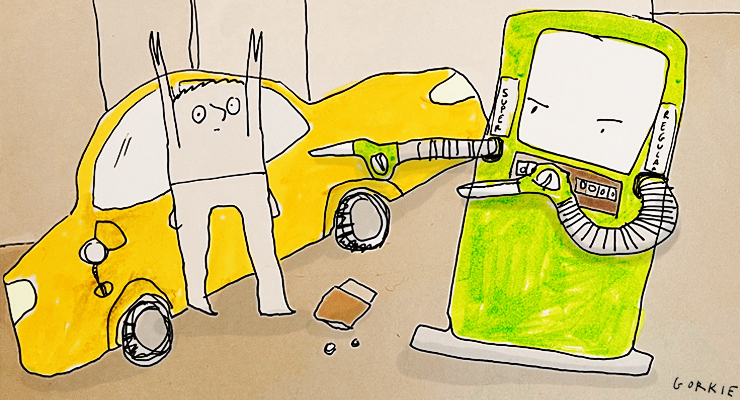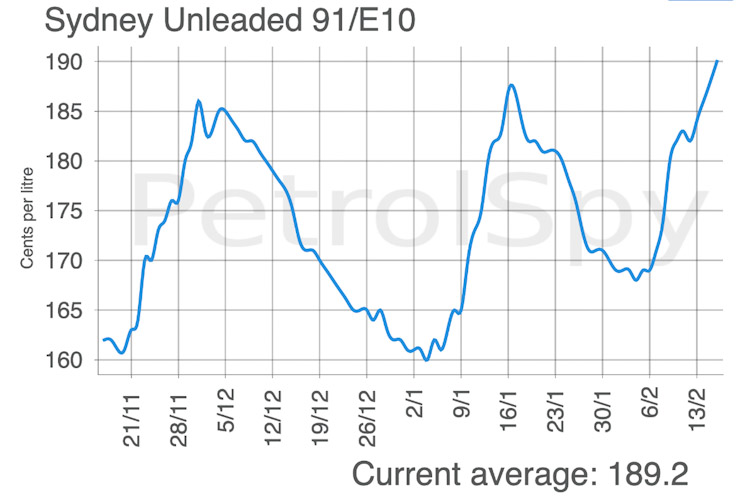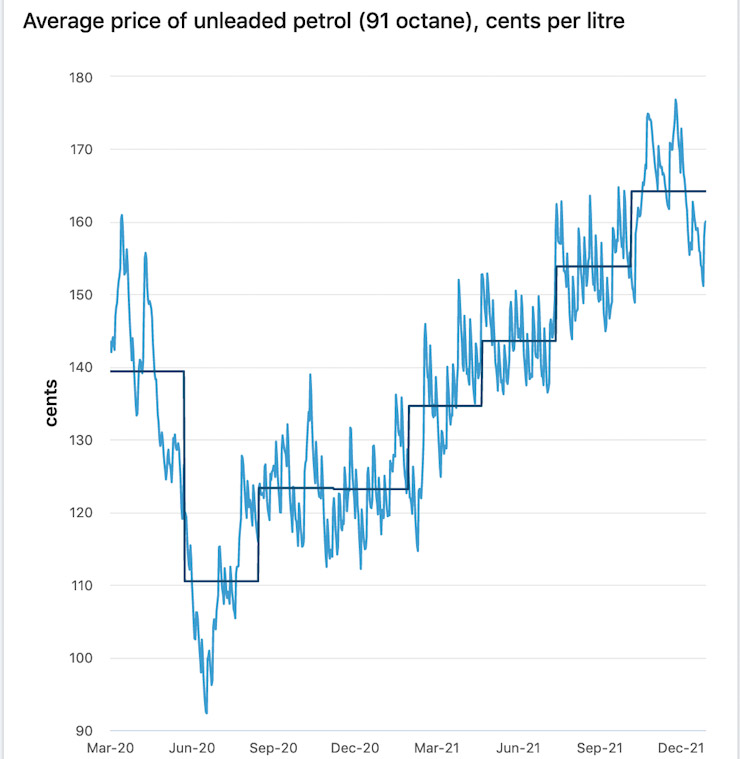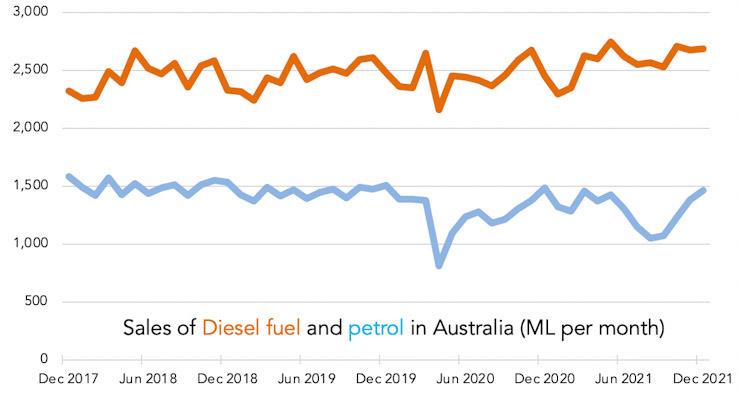
Petrol prices are inexorably sneaking up on $2 a litre. If you fill your car with premium fuel you may have already experienced the curious mathematical phenomenon of watching the dollar dial spin twice as fast as the litres dial. Paying for fuel is an exercise in powerlessness. We do not control the global oil price, which is driven by factors far beyond Australia’s control.

But as they say, it is an ill wind that blows nobody good. Some people are loving the current elevated oil prices. ExxonMobil stock price is up a hefty 25% this year, with the big Texas-based oil firm reporting a whopping profit of US$8.9 billion ($12.3 billion) in the three months of October, November and December 2021.
High oil prices are pure upside for oil companies. Their costs of production barely change, and when prices rise, say due to geopolitical instability or production limits set by the Organization of the Petroleum Exporting Countries (OPEC), they pocket the difference.
ExxonMobil CEO Darren Woods said the company was working to “grow shareholder value”.
“We’ve made great progress in 2021 and our forward plans position us to lead in cash flow and earnings growth, operating performance, and the energy transition,” he said.
You might wonder if an oil company really wants to be leading an energy transition when oil prices are so high. Sticking with oil is lucrative for them; changing is risky.
But oil companies don’t only lead, they also follow. For consumers, high fuel prices make an energy transition even more urgent.
Pain at the pump
Long behind us is the brief period in 2020 when oil price rises went negative in US markets and Australian petrol fell below $1 per litre.

High petrol prices are here and they are hurting. They were the single biggest contributor to Australia’s rising consumer price index in December 2021, and prices seem to have risen further since. Petrol prices are likely to become an election issue.
What do voters do when they feel pain at the pump? Do they take out their anger on the incumbent? Do they get nervous and vote for a party with the supposed reputation for economic management? Or do they vote for a third party that has long been arguing for us to get off our fossil fuel addiction? The answers to these questions are far from certain, but you can expect to see a lot of politicians worrying about fuel prices in coming weeks. A repeat of John Howard’s panicked freezing of fuel excise in 2001 is not out of the question.
Australians use a lot of fuel, so prices matter. The next chart shows sales of petrol and diesel in Australia over the past few years. As you can see, petrol sales dipped in the pandemic and have only barely recovered. For diesel fuel though, sales were relatively steady and are now higher than pre-pandemic levels.

The primary reason diesel has grown is that it is used by machines, not just by passenger vehicles — sales of diesel vehicles have also been very strong. Our new national obsession with enormous four-by-four trucks has caused an increase in the sale numbers, after several years of decline following the Volkswagen emissions scandal.
Around 99% of sedans are now powered by fuels other than diesel, and so are 70% of SUVs. But about 95% of all light commercial vehicles are diesel powered. That includes the most popular vehicle in the country, the Ford Ranger, which sold 46,000 units in Australia last year, about 60% more than the most popular small car, the Toyota Corolla (29,000 units).
The rise of the small car is almost forgotten now. It was a phenomenon of the 2010-2014 period when petrol prices hovered at then-record levels of $1.40-1.50/L (capital city averages). The Mazda 3 and the Toyota Corolla tussled for supremacy in a brief interlude between the primacy of the Holden Commodore and the eventual triumph of the Toyota Hilux. The Hilux became the most popular car after petrol prices fell again in 2015, although it has now been usurped by the Ford Ranger (official fuel consumption, 8.9L/100km, compared to 5.5L/100km for a Mazda 3).
Top dog doesn’t stay top forever
If petrol prices stay high, our car fleet could react. I don’t think Australia will go back to hatchbacks, because the trend to SUVs is so strong. But we could move to smaller SUVs, like the two-wheel-drive RAV4, which uses 6L/100km. We will also likely see rising demand for vehicles powered by different energy sources altogether. The Hybrid RAV4 has been selling like hotcakes with a long waiting list to buy one. It gets 4.7L/100km.
Ultimately, the answer to high fuel prices will be getting off fossil fuels altogether. Electric vehicle sales in Australia are so far quite pathetic — less than 2% of all cars sold last year were pure electric, two-thirds of which were Teslas. The winning policy this election might be a big push to improve electric vehicle availability, giving voters a vision of a future free from ever having to visit a petrol pump.








Electric bike sales are booming. People can see the benefits of bikes for short trips. Govt could achieve several goals quickly by subsidising e-bikes, at little or no nett cost, once you consider the benefits.
A move to road-use pricing would also reduce oil consumption and congestion.
Just don’t buy them in NSW if you want a throttle…
Ultimately, vehicles powered by fossil fuels will become a thing of the past. No doubt, EV and hybrids are the future. But, we could do a great deal to reduce the fuel used and hence emissions created by the vehicle fleet in the interim. For example, diesels can be improved substantially by using hydrogen injection (this reduces emissions by at least 25% and increases fuel economy). For another, we could call out the lying and greenwashing car companies. Toyota insists it is thinking only of the future, yet its most profitable lines are SUV’s and dual cabs and those vehicles are increasingly dominating urban roads AND getting bigger to boot. Aston Martin has now released an SUV with a 700hp engine. I can see why some want that sort of vehicle to massage their egos, but explain to me how the globe needs another large vehicle with a large engine for urban use. Despite that fuel efficiency of most fossil-fuel vehicles has improved dramatically over the last 50 or more years, the average economy of the entire vehicle fleet is no better than it was in 1970 (there are studies that demonstrate this to be true, it’s not just my “opinion”). In 1974, during the then “fuel crisis”, if you owned a V8, it cost a fortune to run and you literally couldn’t give the car away. Now, we scream about fuel prices getting up to $2.00 per litre, but if 100 people went to buy a new car tomorrow, the majority would still buy a dual cab or an SUV – basically to drive to work, the shops and to ferry the kids to school and sport. Our greater modern affluence has meant the petrol price at which we are going to make more environmental choices is still a lot higher than current prices – we really need our big cars, especially those who treat the roads as a war zone and want a “weapon”. Moreover, a substantial majority insist governments must do more about climate change, but statistically, many of those clamouring for more government action are still determinedly buying more and more gas-guzzling and hence high emitting big vehicles. Perhaps fuel prices will rise further and incentivise people to get into smaller vehicles, but I doubt that is going to happen – “we” are firmly wedded to the idea of one person driving a 2.5 tonne vehicle to the shop for milk. Government could do some things – for example, removing the FBT concession on dual cabs that basically allows someone to use a dual-cab as their “daily driver” and, in effect, get a 100% tax deduction for that personal (i.e. not business) use – this costly incentive runs counter to the sort of vehicles that we should be using for daily use. Is the LNP going to take that step? Not likely.
Saw an ad for new Triton dual cab for $23k. Obviously they don’t want to be caught with ICE when the EVs hit.
Agree. One has issues, not just on the increase in vehicle size, which makes no ecological sense and especially, the ‘manager’s salary package’ car; need to tighten up on vehicles for work and tax deductions by including vehicle in salary package, compels the same person to commute using that vehicle every day…..
Fits in with the old ‘Chicago model/urban plan’ based round motor cars, suburbs, free/tollways and oversized energy sinks masquerading as homes equals, increased energy needs and fossil fuel (& auto) income streams.
The mantra of “think global act local” was neatly undermined by libs claims that our country is too little to make an emissions reduction impact. The message this sends to families and individuals leads to bigger dumber vehicles… other bigger polluters are the “real” problem not our collective inaction and inefficiencies. Jago Dodson and Neil Sipe’s work on the oil and mortgage vulnerability of Australian cities is pretty grim and the situation has likely only gotten worse since 2008. Time to dust off the bike and pump up the tyres if you have not used it for awhile. Plenty of roads are great for cycling in the absence of cars. Burn fat not oil. Food prices may spike but the sky will not fall on transport.
“The winning policy this election might be a big push to improve electric vehicle availability, giving voters a vision of a future free from ever having to visit a petrol pump”
That didn’t work well last election. Morrison and his thugs mercilessly attacked a good policy which no doubt contributed to Labor losing the election. Now The Liar from the Shire denies that happened despite the fact it is on video.
.
Why no mention of the shit fuel policy of the Federal Deadheads? New petrol cars in Australia have to have de-tuned motors so they can use the shit that is sold to australia by the international oil cartel. If we had decent, European/Chinese fuel standards we’d have not only better cars, less pollution but also more EVs as manufacturers would have to keep their average pollution levels down.
Something even revheads know, when the vrooming dies down.
One would think that the government would have an each way bet and promote Hybrid cars as the way to go as we change to full electric